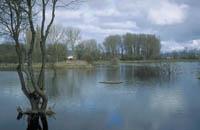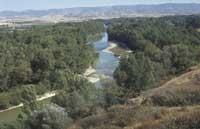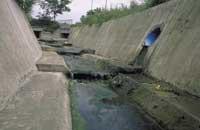Wetlands of the Basque Country (XI): riverside forests and riverside forests (and II)
2001/04/01 Estonba Mintxero, Mikel Iturria: Elhuyar aldizkaria
Wildlife
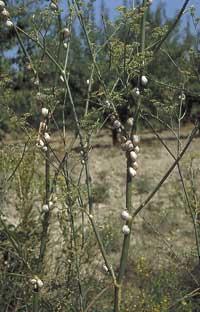
In riparian forests and riparian forests it is difficult to separate the fauna from the banks of the river, except the fish that spend their whole life in river waters, since most of the other animals in these areas are intimately related to their banks and the river: some because they live in the river and live on their bank; others because they cross several stages of their life cycle in waters and others on their banks; and others because they periodically renounce the ecosystem. That is, river faunas and margins are practically inseparable.
In the meanders, in the maternal channels, in the secondary channels and in the prevailing stagnant waters in this type of zone, there are adequate conditions for the life of numerous species of invertebrates. Among the annelids, there are abundant oligots of the genera Stylaria and Tubifex, as well as the hyrudines as the creatures. The bivalves of the genera Sphaerium and Pisidium are the main source of food for numerous species of fish. However, in stagnant waters with abundant vegetation can be found genus gastropods such as Lymnaea, Planorbis, Ancylus, Acroloxus or Viviparus.
However, arthropods are undoubtedly the most abundant and most species humid ecosystems. As for crustaceans, a high percentage of zooplankton consists of entomostraceae, colepods and other microscopic crustaceans.
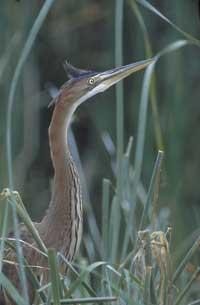
Ostracodos also abound in the bottoms. The best known are macroscopic crustaceans such as crab, quisquilla, isopods of the genus Asellus, amphipods of the genus Gammarus...
Among insects, although there are species that carry out their entire life cycle in the water, are more abundant those that perform the larval phase of the life cycle in the water and the adult phase on land. Among the latter, due to their spectacular body anatomy, dentists (brooches and skewers) deserve special mention. Gomphus, Anax, Calopteryx, Sialis... are many species of genus that inhabit the stagnant waters of the banks of the rivers and of the riparian forests, although in larval phase and of maturity do not go too far from these aspects.
But in addition to dentists, there are other insects closely related to river ecosystems and margins. The aquatic larvae of the ephemeropters, which are characterized by having a very short ripening period, constitute an important part of the diet of the vertebrates of these ecosystems, as well as the larvae of the tricopters that are characterized by living inside the ducts that they themselves construct or the larvae of the nematoceros (mosquitoes) that must approximate the surface of the water to be able to breathe.
Among the ephemeropters, some species of the genera Cloeon, Caenis, Ephemera or Heptagenia are very visible in our rivers.
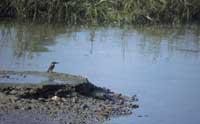
Among the tricopters are Limnophilus, Glyphotaelius, Anabolia, Crunoecia, Goera, Molanna... Among the nematoceros are the genera Culex, Corethra, Chironomus or Simulium.
Among those who spend their entire life cycle in the water are coleoptera. Although adults collect air under the elliptics, they often have to climb to the surface of the water to breathe. Most species, both larval and adult, are carnivorous and skillful swimmers and divers. Aquatic coleoptera include several species of the genera Acilius, Dytiscus, Platambus, Gyrinus and Hydrous.
As for vertebrates, these humid forests have immense richness and diversity. Among the amphibians, the most abundant are the marmolaire triton, the common frog and the common toad and the corridor, but in the Mediterranean region, to which must be added the txantxikua, the spur toad and the Iberian painted toad.
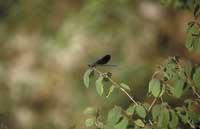
As for the reptiles, in addition to the species of swimming snakes (eve snake and omada snake), you can observe in these areas a pond and current tortoise in the riverside forests to the south of the territory, as well as a common dragon.
Among mammals, the best known are otter, water mink and common tail, which does not mean that they are the largest, since micromammals are many more. Many species of sargos, sargos, moles, mice and rats exploit the large amount of trophic resources offered by these forests of water and land. In addition, there are other mammals that, without belonging to these ecosystems, are frequent in them, such as the badger, the fox, the gineta, the garduña or the wild cat.
However, as occurs in most other types of wetlands, birds are the most abundant among vertebrates, since in addition to most bird species adapted to live in humid and aquatic ecosystems, in the trees of forests and riverside forests of the banks and in areas of dense vegetation coexist numerous terrestrial species. In the south of Euskal Herria, in addition, for the aforementioned terrestrial birds, these forests are of great importance, since the large farms of this region have made the rest of the types of forests become a void, so the riparian forests are the only areas where these birds are to live.
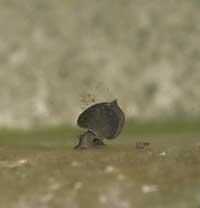
In the rivers of the Euro-Siberian region, the aquatic myrtle, the kingfisher, the madroño and the yellow washerwoman are the most dependent on water, since they feed there. In the alisedas that form on the banks of the aforementioned rivers you can observe numerous paseriformes, such as dry, refractory, carnations and amillitas, zorzales and myrtle, txepetxas, birds, etc.
In the riverside forests of the Mediterranean region, in addition to the alisedas mentioned, in the vicinity of the water, there are birds such as heather and divers; several species of duck; storks; egrets, egrets and birds; chickens and foxes...
However, in the erosive escarpments generated by the dynamics of rivers outside the meanders, birds such as the cornice or the flood find the right conditions to nest. On the other hand, in the carrizales that often develop in the maternal or secondary channels, inhabit birds such as carrizales, carrizales, reeds, verdinas or requisos.
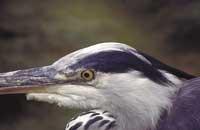
However, the greatest richness of birds is found in the massifs and choperas of the riverside forests: birds, cucos, urretxoris, tortolas, lentils, antzandobias, pseudo-birds, heather, mattresses, large hawks, black milanos, alimoches, small eagle, wonderful marshes, etc.

Gai honi buruzko eduki gehiago
Elhuyarrek garatutako teknologia



